GreenGeeks is one of the most popular companies for eco-friendly hosting in 2025. The web host uses renewable energy to reduce its carbon footprint (yours too) and claims that each hosting package they sell equals planting a tree. But is the web host actually good at hosting websites or is it just a mediocre company advertising green web hosting?
To answer those questions and many more, we decided to review GreenGeeks services in 2025 to know how good the web host is. This will help you determine if you should host your website with them or not.
This article reviews the services of GreenGeeks in many aspects, thus letting you know its strengths and weaknesses to determine whether it is good for your business. Are you ready to find out? If you replied yes, keep reading!
GreenGeeks Pros and Cons
| Pros | Cons |
|---|---|
| Easy Account Management | Limited Data Centers |
| Great Security | Shady Refund Policy (Setup Fee Non-Refundable) |
| Outstanding Speed and Uptime | High Renewal Prices |
| Free Domain & SSL | Cannot Handle High-Traffic Sites |
| Eco-Friendly Hosting |
Account and Site Management Review: Is GreenGeeks Easy to Use?
One of the first things we tested after purchasing our GreenGeeks hosting account (Lite) was the dashboard. Our aim is to check how easy it is and the challenges that beginners with little technical-know may face.
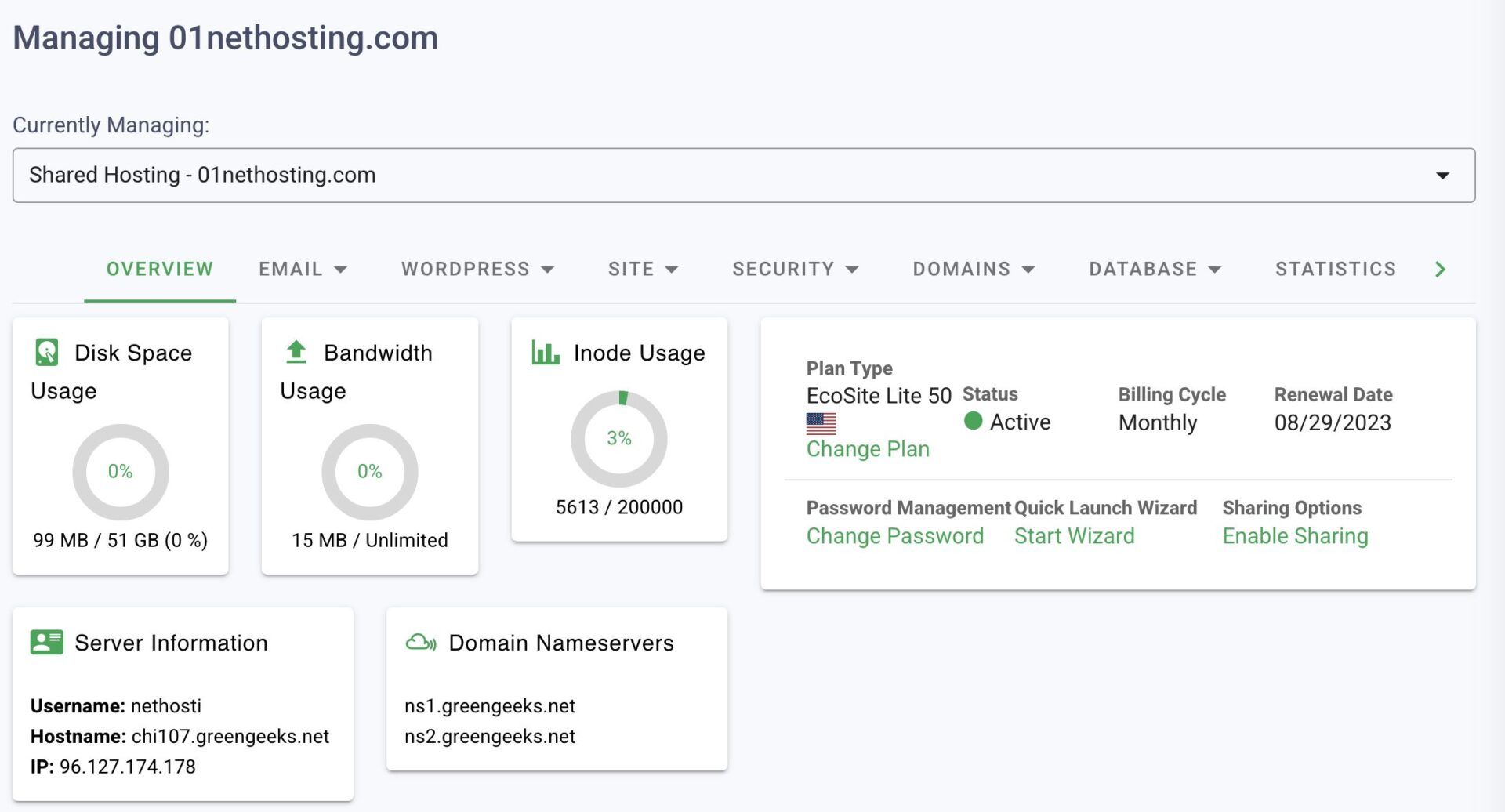
After testing the GreenGeeks dashboard, all we can say is that it is extremely easy to use in our opinion. Once you log in to your GreenGeeks account, the first page you will see is the Dashboard that lists all the hosting plans you have with a link to either manage each from your account or use the cPanel. It has links to your support ticket too. Looking to your left, the sidebar contains direct links to some crucial parts of account and site management. You can access hosting, domains, security, and support pages from there.
In addition, when you decide to manage a hosting account, you can easily switch between the sites. On the management panel for each website on your account, you will have access to everything you need. All the controls and settings for your website are arranged in tabs or menus on the screen.
Each tab or menu item represents the general name for the settings and has sub-items that link to the actual or particular settings you want to manage. For instance, the DOMAINS tab or menu item has links to every setting you can customize for your domains while the SECURITY tab links to the security settings for your site (SSL, etc.). The OVERVIEW tab shows your bandwidth, storage space, and inode usage with some information regarding your server.
Drawing from our experience during the review of the GreenGeeks dashboard, this setup makes management quite easy for anyone, especially beginners. You don’t even need to leave your dashboard to the cPanel because you can easily install WordPress and manage your installation from there. Though, you need the cPanel to install other web apps, scripts, or CMS on your website.
Speed and Performance Tests: Is GreenGeeks Fast?
Speed and performance tests form an important part of our GreenGeeks review for 2025.
Drawing from our experience, speed is very essential when choosing a hosting company for your website. This is because website loading speed determines a lot of things and it affects your overall success as a business online. How?
A website that loads very fast ensures that users are able to see the content they came over for very fast. Besides, when they want to check out other content on your website, they will have smooth and fast navigation. Thus, they would have a good user experience. This will make them repeat visitors and make your analytics extremely valuable or successful.
At the same time, your bounce rates will decrease since users are having a good experience and Google will pick up on this to improve your search rankings. Therefore, you will start getting more traffic and an increase in potential clients.
GreenGeeks GTmetrix Tests
The first tool we used for our 2025 GreenGeeks tests was GTmetrix. This is a powerful performance testing tool that shows how a web page performs when real visitors visit it. It measures the data and results with the benchmarks set by the Core Web Vitals and grades the web page to know if it fails or passes the test. GTmetrix also provides advice on what to fix to improve your speed and performance.
GTmetrix Metrics
Before we dive into the results we got for our GreenGeeks GTmetrix speed performance review, it is important to know the terms used and what they mean.
- Time to First Byte (TTFB): The TTFB is how long it takes the server hosting a site to give the first response to the query of a user’s browser. This is when the server basically makes a connection with the browser and begins to transmit data. Ideally, TTFB should not take longer than 0.8 s.
- First Contentful Paint (FCP): This is how long it takes the first visible item on a user’s screen to display fully. This could be a text, a button, an image, etc. An ideal FCP is 1.8 s or less.
- Largest Contentful Paint (LCP): It measures how long it takes the largest visible item on a user’s screen to fully display. This could be a big hero image or background video, a button, etc. Ideally, LCP shouldn’t be slower than 2.5 s.
- Cumulative Layout Shift (CLS): This indicates the stability of elements on your web page(s). This is influenced by how responsive your site or theme is based on the arrangement or implementation of your JS, CSS, and HTML elements. A good CLS should be 0.01 or less, and it influences the perceived user experience on a page.
- GTmetrix Grade: The Performance part of the GTmetrix grade measures how your site fairs when the results are compared with the standards set by the Core Web Vitals. On the other hand, the Structure part shows the overall performance of your site’s structure in terms of speed. Both parts are measured between 0 – 100%. While 0% means bad, 100% means good. 90% and above indicates a good overall performance and a chance to pass the Core Web Vitals test for SEO.
First GTmetrix Test Results
We did our first GreenGeeks GTmetrix test shortly after our onboarding process and the installation of WordPress on our site. For the test, we installed and activated the Twenty Twenty-Two theme after deactivating other themes. Only LiteSpeed Cache was active, but we did not alter the default settings. So we commenced the GreenGeeks speed review by analyzing the site with GTmetrix.
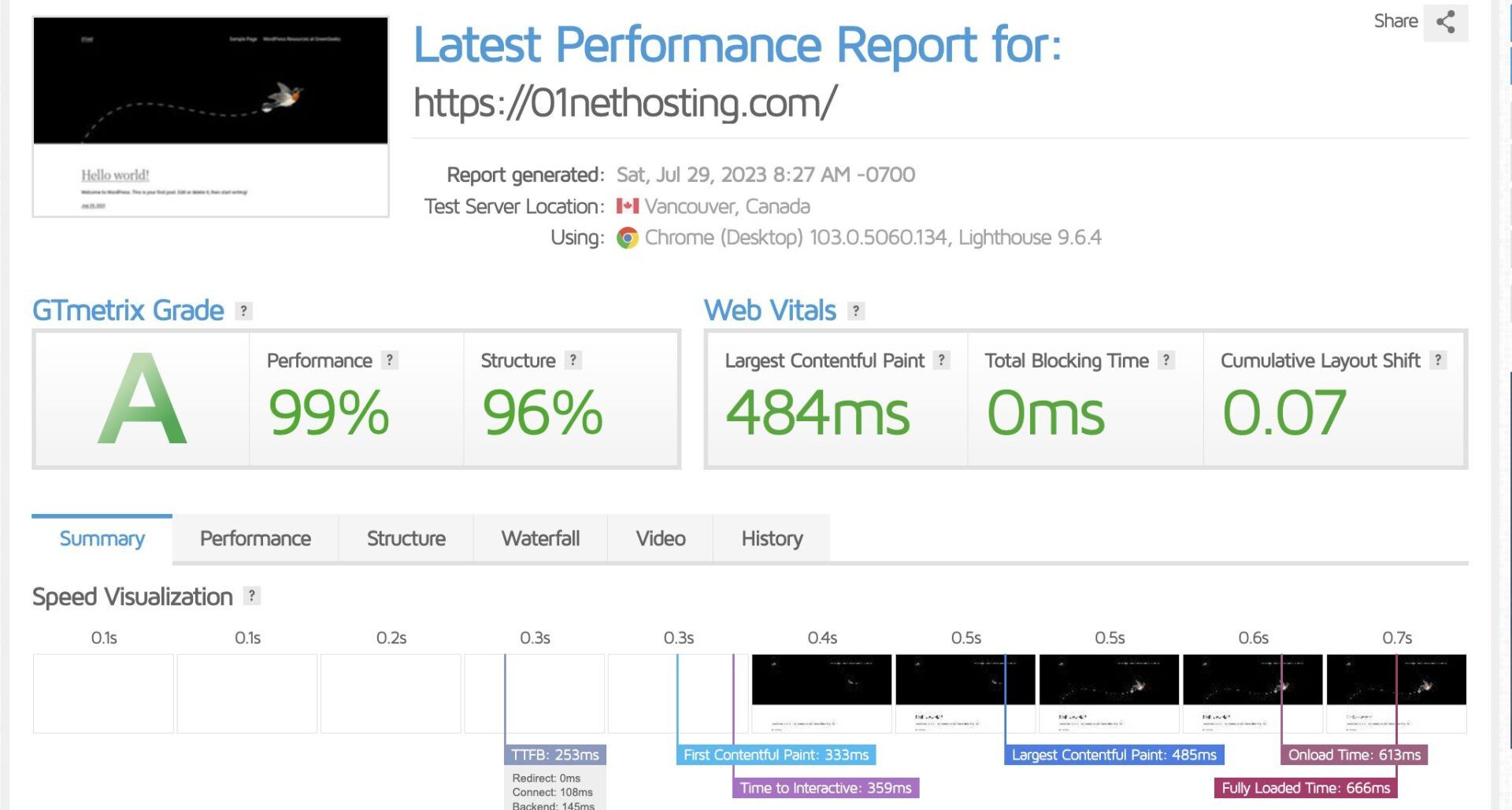
Upon analysis, we recorded a TTFB at 253 ms which means our server is quite fast and passes the set benchmark.
Our FCP and LCP were recorded at 333 ms and 485 ms, respectively, indicating that the server with the help of the solid state drives (SSD) was able to load the images very fast. Although, they could have been improved if GreenGeeks uses NVMe SSD rather than the SATA version. Competitors like Hostinger and InMotion do. In this situation, the performance will suffer if you host a media-heavy website.
Further, we recorded a CLS at 0.07 which is bad but associated with the theme in use. From our experience running tests on web hosting services like GreenGeeks, this CLS has been consistent with the Twenty Twenty-Two theme. Our opinion is that it is not well-optimized.
At the same time, we recorded a fully loaded time at 666 ms indicating that our web page was very fast. Not only did it beat the recommended 3 s loading time, but it loaded in less than 1 s.
Overall, GTmetrix graded our GreenGeeks test page 99% for Performance and 96% for Structure. This indicates that we are in the clear. Our web page will not have any issues with loading speed, bounce rates, and user experience.
Nonetheless, based on our firsthand experience reviewing GreenGeeks alternatives like InMotion Hosting in 2025, we have seen better results for this type of configuration. For instance, we recorded 239 ms, 308 ms, 427 ms, and 534 ms for TTFB, FCP, LCP, and fully loaded time for InMotion Hosting, respectively. We had 99% in both Performance and Structure too. This shows that InMotion is better in all speed-related aspects.
Here is a summary of our first GreenGeeks GTmetrix test results:
- TTFB: 253 ms
- LCP: 485 ms
- CLS: 0.07
- Fully loaded time: 666 ms
Second GTmetrix Test Results
We conducted our second GreenGeeks GTmetrix test using a different approach. We installed the Neve theme and imported one of its starter sites with all its content.
This is because we wanted to know how the server will perform when hosting a fully functioning site. So we are giving the server more tasks here. Like the first GreenGeeks test, we didn’t make any customizations.
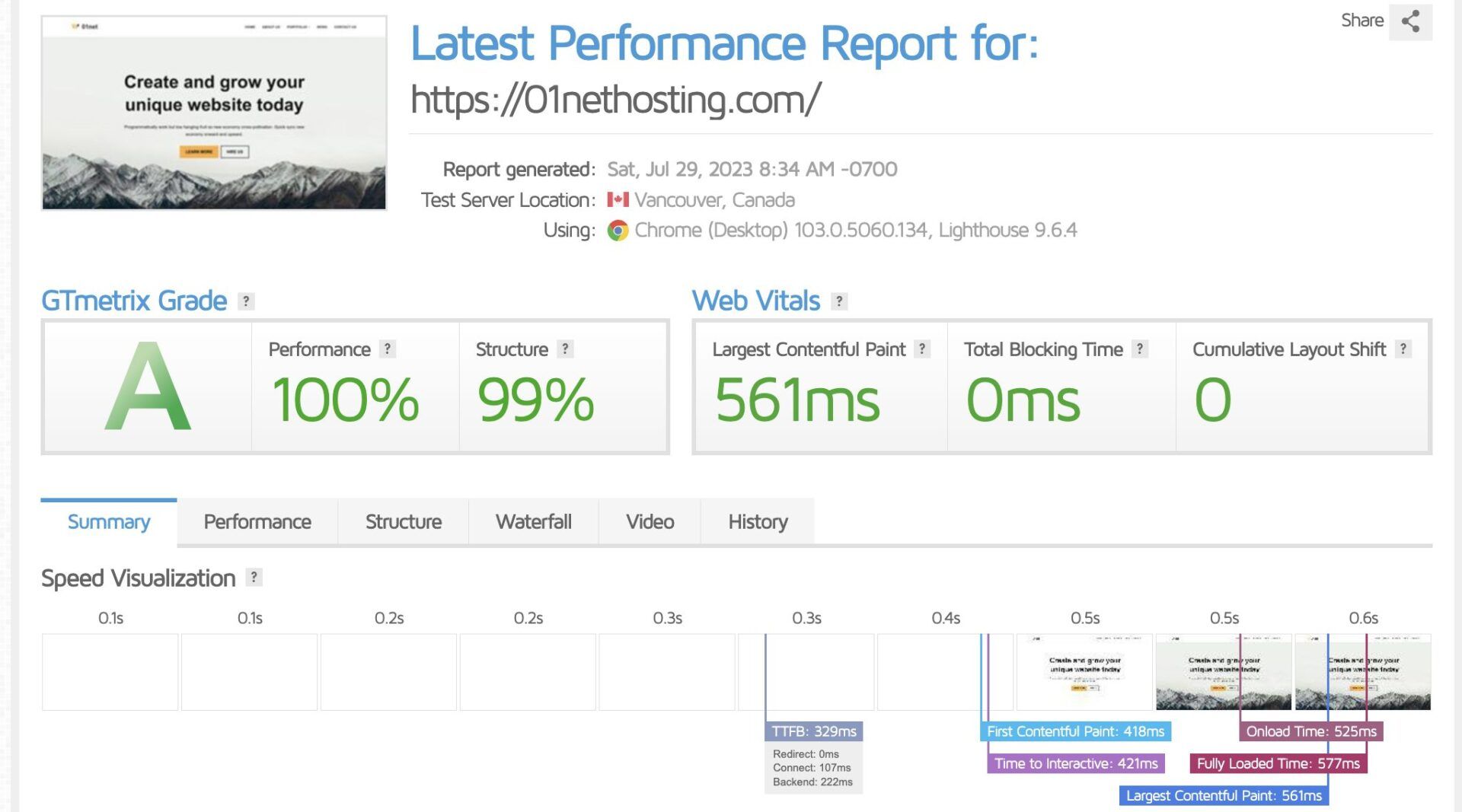
After analyzing our test web page with GTmetrix, we recorded a TTFB at 329 ms. This is worse than the first result, but it was expected since it is a more sophisticated web page. Yet, the server still makes a connection with users very fast.
What’s more, we recorded FCP and LCP at 418 ms and 561 ms, respectively. There is a significant drop in both results which is still okay. It proves the point that the server may not be able to handle a media-heavy site.
Further, we recorded a perfect CLS of 0. We expected this to happen since the Neve theme is well-optimized.
Moreso, we recorded a fully loaded time at 577 ms. This result shows that our web page loads very fast. Besides, there is an improvement compared with the first test. This happened because of the improvement in the CLS. The page didn’t have to shift its layout and take a longer time to settle/fully load.
Conclusively, we 100% and 99% in Performance and Structure, respectively, indicating that the page doesn’t have any speed issues.
However, like the first GreenGeeks test, InMotion performs better for this configuration as well. The TTFB, FCP, LCP, and fully loaded time were 312 ms, 420 ms, 506 ms, and 530 ms, respectively. Hence, we recommend getting a hosting package from InMotion to give your site great loading speed.
Here is a summary of our second GreenGeeks GTmetrix test results:
- TTFB: 329 ms
- LCP: 561 ms
- CLS: 0
- Fully loaded time: 577 ms
GreenGeeks PageSpeed Insights Tests
The second tool we used for our GreenGeeks performance test was Google PageSpeed Insights (PI). This tool analyzes web pages by comparing their performances with the standards set by the Core Web Vitals. Since Google developed the Core Web Vitals and owns PageSpeed Insights, the results here are much more reliable for SEO. They show how Google sees your site and determine your potential SEO performance. PI also gives suggestions on how to fix any issues that may be affecting your site’s performance.
Desktop Test Results
- 100 Performance score
- FCP: 0.4 s
- LCP: 0.5 s
- CLS: 0
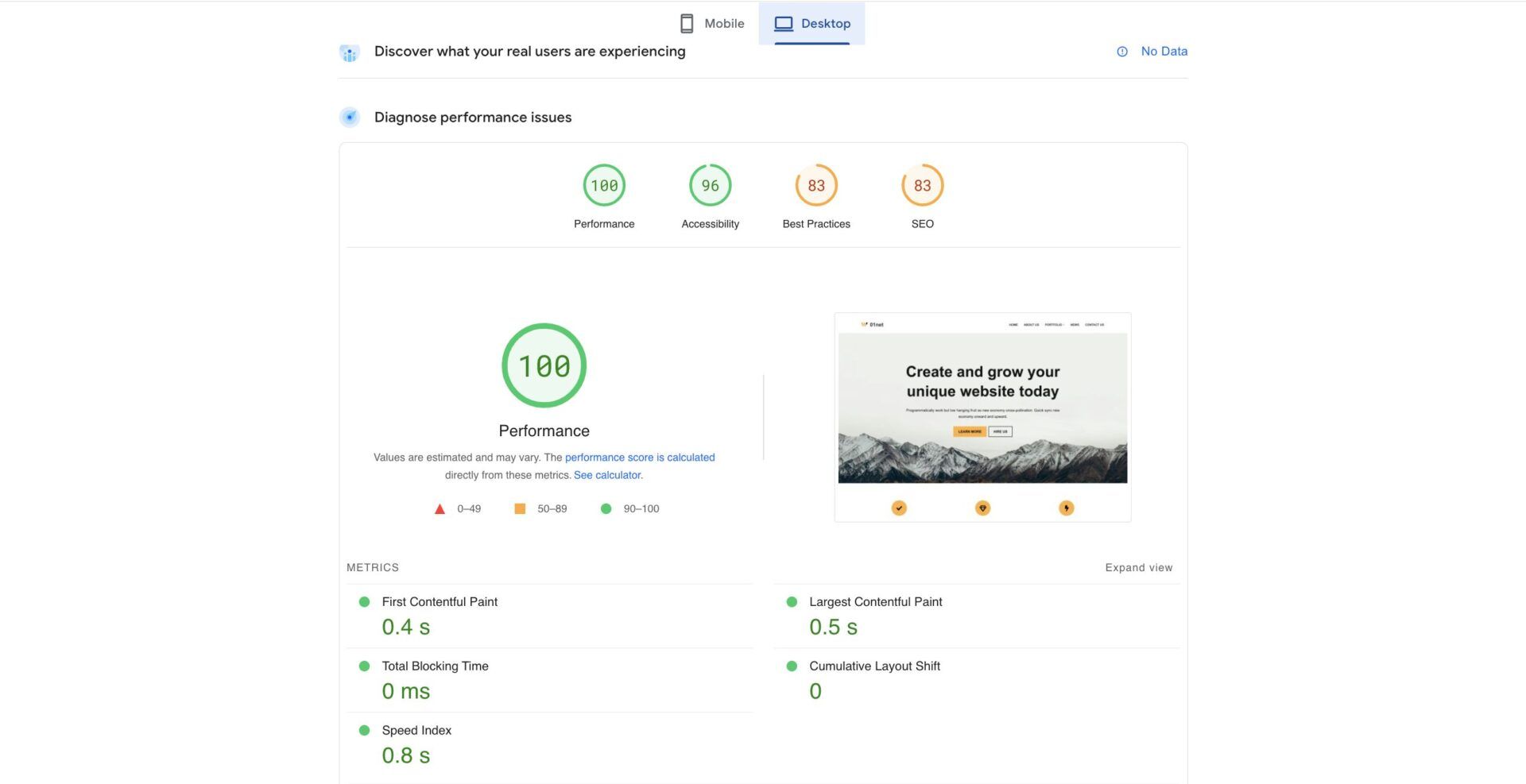
From the results, we can that our GreenGeeks website passed the PageSpeed Insights test for desktops. The FCP and LCP are fairly consistent with what we recorded with GTmetrix even though they are approximates. Thus, Google sees no issues with the site and it has the chance to rank high for searches from desktop users.
Mobile Test Results
- 99 Performance score
- FCP: 1.2 s
- LCP: 1.9 s
- CLS: 0
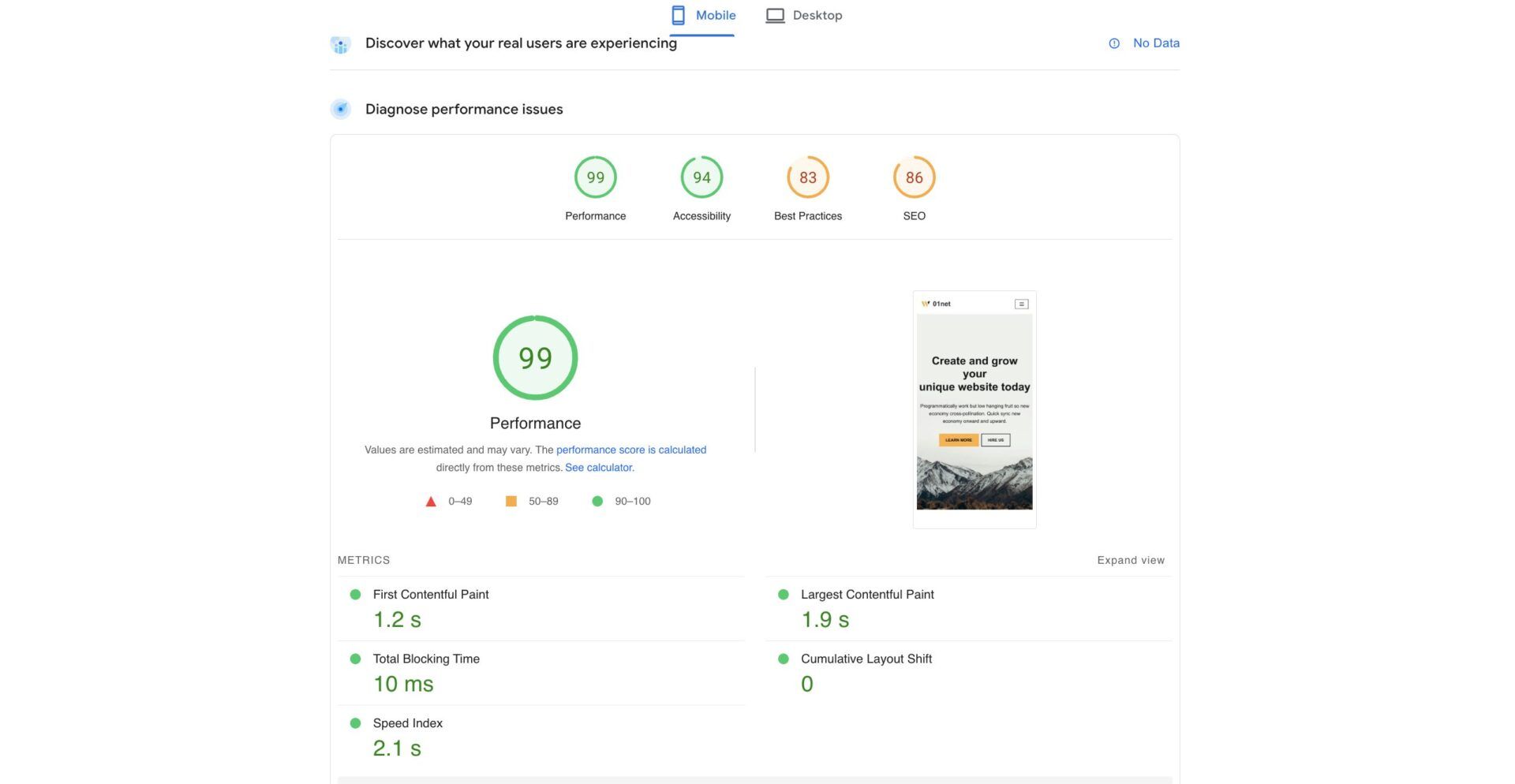
Judging from the results above, we can see that there is a significant drop in all related aspects. This was expected mainly because pages are relatively slower on mobile devices than desktops because of their processors. They have smaller and slower processors. Nonetheless, our GreenGeeks site still passed the mobile tests and will excel in Core Web Vitals too. So, there is nothing to worry about in terms of speed.
GreenGeeks Review: Performance Technologies
After our GreenGeeks speed tests, we looked into what makes the host tick in terms of performance. Our findings have shown that GreenGeeks uses the following technologies:
- LiteSpeed: This is a web server that is used to power resource-demanding projects. It is one of the fastest on the internet and can handle heavy-traffic websites while delivering top loading speeds and performance. GreenGeeks used LiteSpeed on all its server.
- LSCache and LSCWP: LSCache refers to LiteSpeed Cache and it is server-level caching technology built into LiteSpeed servers. It helps to cache dynamic PHP content on platforms like WordPress, Joomla, Drupal, etc. so that sites or web pages using them load very fast upon duplicate requests. LSCWP refers to LiteSpeed Cache for WordPress plugin. It is a tool for improving web optimization on a WordPress website.
- Redis: Redis or Redis Object Cache is a technology that stores copies of your site’s databases in your server’s memory so that dynamic content or information is readily available to your visitors whenever they request it. This makes processing their requests faster and leads to better-performing pages with faster loading speeds.
- CDN: Although GreenGeeks does not have a Content Delivery Network (CDN), it allows you to connect with anyone you want. You can use Cloudflare CDN, for example, to distribute copies of your web pages worldwide and enjoy lower network latencies and faster loading of your web pages which will improve your site’s SEO performance.
- SSD: The host also uses solid state drives (SSD) to store your website files. These drives are better than hard disk drives (HDD) in terms of speed and performance. Hence, your server will have a better read/write speed than traditional servers and this means better performance or loading speed for your site.
- HTTP/3 and the Latest PHP Versions: Our review shows that GreenGeeks supports HTTP/3 which increases the speed, security, and reliability of data transfers between your server and users’ browsers. It supports multiple PHP versions too to help your site take advantage of every performance tweak in the latest versions.
GreenGeeks Has Limited Data Centers
Our findings during the review of GreenGeeks services in 2025 have shown that the host has multiple data centers. It has four data centers in North America (USA), South America (Canada), Europe, and Asia (Singapore). This allows you to choose the best data center that works for your site based on the location of your main audience. Hence, you can reduce the effect of network latency and deliver fast-loading web pages to your visitors. This improves your SEO performance as well.
Nonetheless, the data centers offered by GreenGeeks are not enough in our opinion. For instance, it has only one data center in the United States and it does not specify its location. So we don’t know if it is closer to the East Coast or the West Coast. Although, our findings have shown that the data center is in Chicago, Illinois. Besides, if you want to change your data center, you will have to pay almost $30 for the relocation. This is a free service on Hostinger.
Yet, while reviewing some options like Hostinger and SiteGround, we discovered that they provide more and better data centers. SiteGround has 11 data centers and 16 CDNs while Hostinger has 9 data centers. These hosts all specify the location of their data centers and they spread more around the world.
GreenGeeks Load and Response Tests
Another important action we took was to test the GreenGeeks server hosting our site for load strength and response times. This was necessary because our experts decided to experiment with the GreenGeeks server to see how it performs during traffic surges. It will also help to determine if GreenGeeks is suitable for hosting a high-traffic site or not.
For this part of the review, we sent virtual visitors to our GreenGeeks site using a tool called Loader.io to see the response times. We ensured that the visitors all visited the site within one minute and set the error rate to 50%. This error rate means that if more than half of the visitors didn’t see the page, then the server failed. The timeout for when to determine a user didn’t see the page was set to 10 s.
First Load Test
We sent 20 visitors to our GreenGeeks test website for the first experiment. After one minute, we recorded the fastest, average, and slowest response times at 246 ms, 297 ms, and 1175 ms, respectively.
Judging from the slowest response time, it indicates that our server took more than one second to connect with some visitors. This is terrible since it fails the TTFB test that has 0.8 s as the benchmark. This will significantly affect other performances too. Although, the average response time (297 ms) is still acceptable.

Our expert opinion from the results of this test is that the GreenGeeks server can handle 20 visitors in under one minute but not at its optimal performance. Conversely, Hostinger does better in this category with 45 ms, 58 ms, and 309 ms, for the fastest, average, and slowest response times, respectively under the same circumstances or configuration.
Second Load Test
We increased the pressure on our GreenGeeks server by sending 50 visitors in under one minute for the test. Upon testing, we recorded the fastest and slowest response times to be 231 ms and 1477 ms, respectively. On average, the server responded to visitors within 238 ms. These results are worse than what we recorded for the first experiment. The slowest response time failed the TTFB test again.

On the other hand, SiteGround passed the test with flying colors with 137 ms, 149 ms, and 292 ms for the fastest, average, and slowest response times, respectively. This indicates that a SiteGround server will handle 50 visitors within one minute better than a GreenGeeks server. The former will not even experience a decline in performance.
Third Load Test
It was very disappointing that our GreenGeeks server failed this test woefully! I mean, they use LiteSpeed web servers.
For our third load test, we sent 1000 visitors within one minute to our website. Sadly, we recorded 10202 ms, 10210 ms, and 10242 ms as the fastest, average, and slowest response times, respectively. The error rate was 100%, indicating that the server crashed and couldn’t deliver the page to any of our visitors. Not even one of them! This means the server cannot handle 1000 visitors within one minute and is not suitable for hosting a high-traffic website.
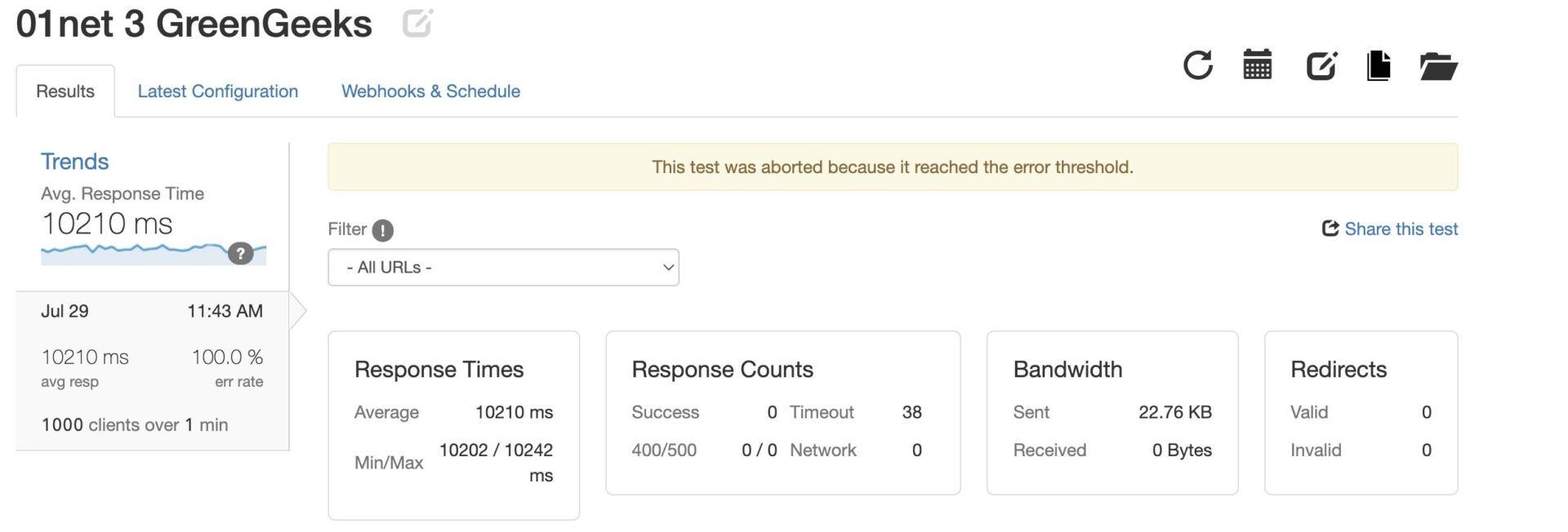
Conversely, we recorded better results with GreenGeeks alternatives like Hostinger and SiteGround for the same configuration. For Hostinger, we recorded 43 ms as the fastest, 47 ms as the average, and 301 ms as the slowest response times. At the same time, we recorded the fastest, average, and slowest response times at 135 ms, 143 ms, and 442 ms, respectively for SiteGround.
GreenGeeks Uptime Test: Is it Reliable?
Another aspect we looked into during our review of GreenGeeks services was uptime. Uptime is very important to every website as it indicates how long it stays up in the course of a specified length of time. This could be a month, 6 months, or a year.
A good uptime means that your website stays online for the most part of the calculated time and didn’t experience significant downtime. When your site has good uptime, it makes your business reliable since visitors will always access it whenever they want. It boosts your SEO performance, traffic, and revenue as well.
Conversely, bad uptime can cripple a business because it will make visitors and buyers seek alternatives without looking back. It makes your business unreliable too and affects SEO performance badly.
Therefore, we want to test the GreenGeeks server to ensure that it delivers great uptimes. For the review, we took a look at the uptime of GreenGeeks that Pingdom monitors. To our delight, our findings show that GreenGeeks has good uptime.
In a span of 6 months, GreenGeeks maintained 100% uptime for 3 consecutive months and never went below 99.97%. On average, we calculated the uptime for this period to be 99.992%. This is quite great uptime and it means you can trust GreenGeeks if you want your site to be online most of the time. Yet, if you want more reliable hosts, you can try SiteGround (99.998%), Hostinger (99.997%), and InMotion Hosting (99.995%).
GreenGeeks Review: Pricing and Features
As part of this GreenGeeks review, we also looked at the pricing and features offered on each plan.
The main aim of this review is to determine whether GreenGeeks is affordable or not and to know if it offers great value for money. GreenGeeks provides several hosting types which are shared/WordPress, VPS, reseller, and dedicated server. Our main focus for the purpose of this article will be the shared hosting type with its plans and features.
Generally, all shared/WordPress hosting plans include unmetered bandwidth, a free domain name for one year, free email hosting, free built-in caching (LSCache) & CDN, automated daily backups, unlimited databases, and free SSL certificates. At the same time, they include multi-user access, managed WordPress features (automated updates of Core files, plugins, and themes), a 30-day money-back guarantee, firewalls & DDoS protection, free malware cleanups, LiteSpeed (web server & LSCWP), and cPanel control panel.
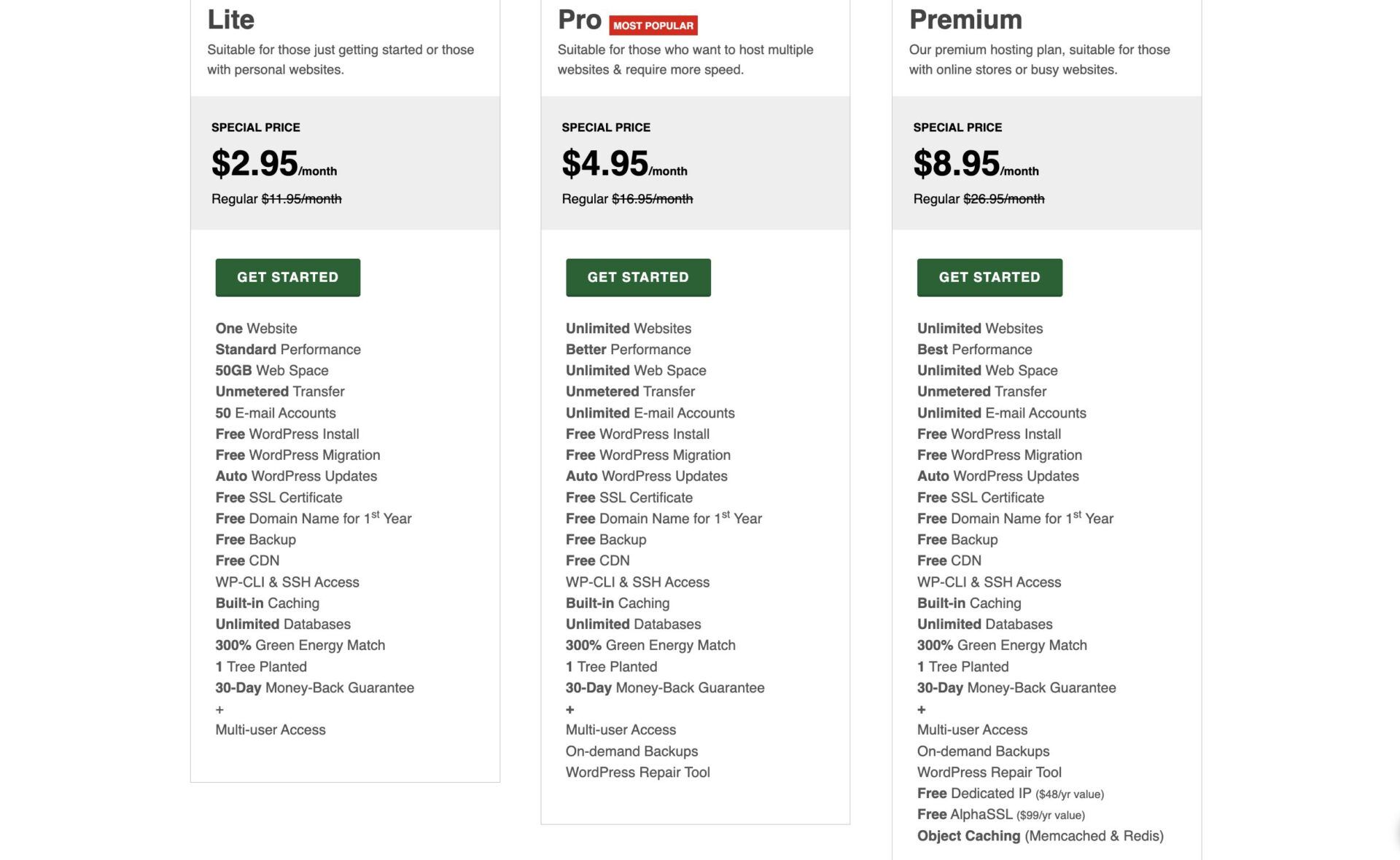
GreenGeeks has only 3 shared hosting plans which are Lite, Pro, and. Premium. The Lite plan is the lowest package that costs about $3 per month and renews at almost $12 monthly. It has a server with standard performance and can host only one site. You will get 50 free email accounts and 50 GB of disk space. So, we don’t recommend it for a media-heavy website.
The next plan is Pro which costs about $5 per month for the initial subscription and renews at about $17 monthly. It allows you to host unlimited websites with a better-performing server and unlimited storage space. It also includes unlimited email accounts, on-demand backups, and a WordPress Repair Tool. The WordPress Repair Tool allows you to fix WP issues with just a click on your GreenGeeks dashboard. You don’t need any technical-know to use it.
The last package on GreenGeeks is Premium which costs about $9 monthly and renews at almost $27 per month. It includes all Pro features but with a more powerful server for the best performance. It also comes with a free dedicated IP address, Object Caching (Memcached & Redis), and free AlphaSSL.
In our opinion, after a careful review of the features, we can say that GreenGeeks is not quite affordable based on the renewal prices. Although it offers some great features. If you need a more affordable web host with better value for money, you should try Hostinger for packages as low as $2 per month for initial subscriptions and $4 monthly renewals.
Shady Money-back Guarantee and Refund Policy
Our findings during the review of GreenGeeks services have revealed that the web host has a 30-day money-back guarantee. However, there are so many things to note about this guarantee.
First and foremost, the refund applies to only hosting plans that are canceled within the first 30 days of account activation. If you renew your account and decide to cancel, you will not get a refund even within the first 30 days of renewal.
Besides, other services like domain registrations, add-ons, SSL certificates, or even dedicated server hosting plans are not eligible for refunds at all. At the same time, if you purchase a monthly plan, the setup fee will not be refunded when you cancel your plan. The exact reason behind this is unclear and we were a victim!
Good 24/7 Customer Support
Another area we looked at during our GreenGeeks review for 2025 was customer support. It is important to choose a hosting company that has a great support system to ensure that you can get real help any time you need it. Otherwise, you will spend more time trying to fix issues on your website rather than actually running your business.
Our research indicates that GreenGeeks has a working 24/7 customer support system. It provides support via live chat, emails, and a ticket system. While the live chat and emails are available to even non-customers, the ticketing system is available to only active customers since you have to log into your account.
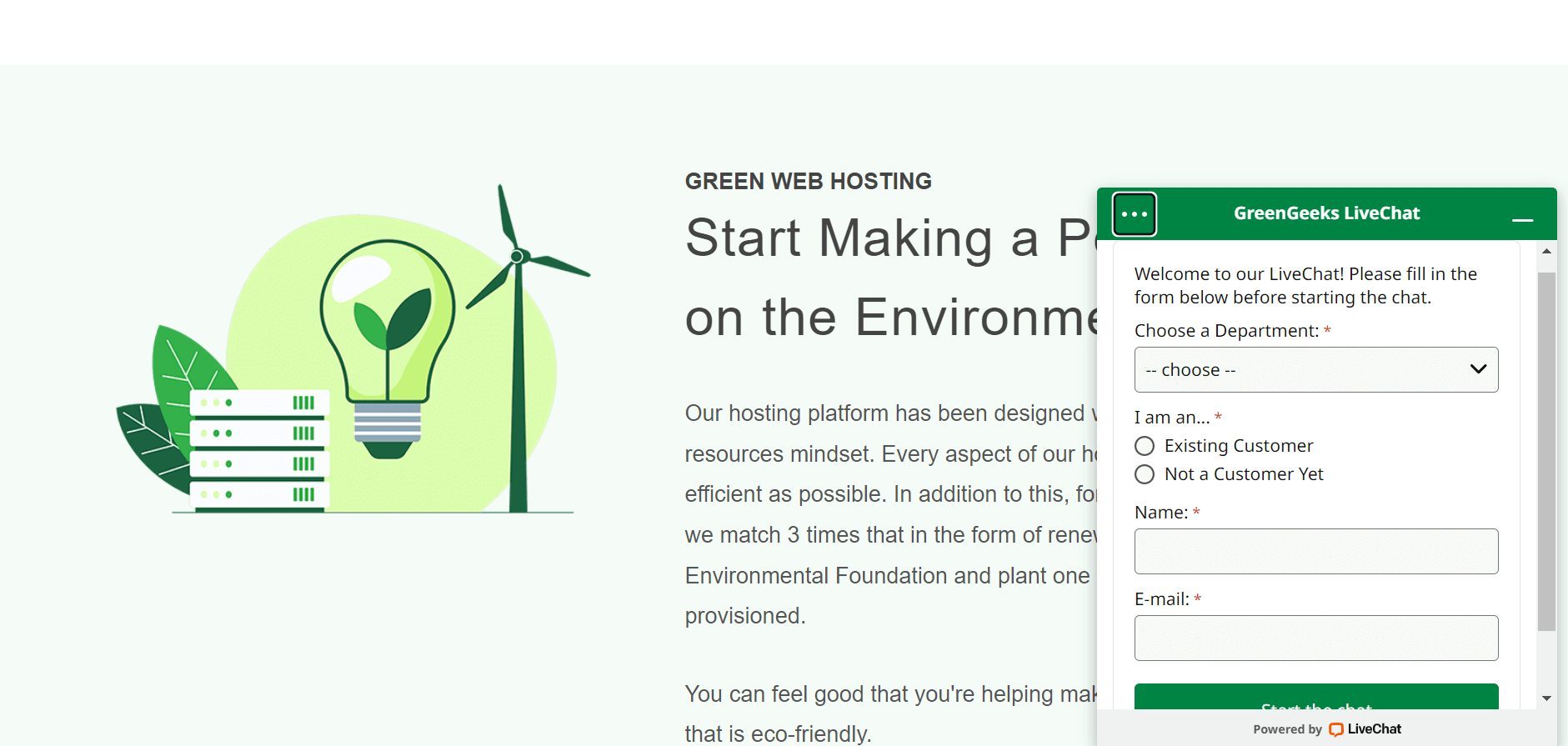
Drawing from our firsthand experience, GreenGeeks has a very reliable live chat support system that is really available 24/7. The support team is fast and competent with the spirit of assisting. One of the downsides, however, is that the queue can be really long sometimes and it takes several minutes to connect with an agent. But once the connection is made, the rest is very swift and delightful.
Aside from human support, you can also get help using GreenGeeks Support Center. This includes numerous helpful articles regarding common issues users have and the web ways to fix them. They are divided into several sections and there is a search function on top of the page to enable you to find what you are looking for easily and fast. Some are just articles that aim to increase your knowledge about some topics. Nonetheless, they are well-illustrated and even the screenshots are annotated. This makes it easy to follow them and resolve your issues very fast.
Aside from that, it has some helpful articles under Website Tutorials that assist you with emerging site issues and how to handle them. Some are just informational and there to help you learn tools you can use on your site for better performance. For instance, using AI with your WordPress website.
Overall, after reviewing GreenGreeks customer support, we can say that the host is very good in this aspect, in our opinion.
Discover GreenGeeks Hosting Plans
Security Review: Is GreenGeeks Secure?
That question must have been on your mind since the beginning of this article. No worries, our review of GreenGeeks services for 2025 cannot be complete without a mention of its security features.
Our findings have shown that GreenGeeks is in fact very secure because of the security features it provides. The web host gives free AutoSSL certificates which you can install via the cPanel to protect the exchange of data between your users and your server. Alternatively, you can install Let’s Encrypt SSL certificates for free instead via your GreenGeeks dashboard.
Furthermore, the host provides free automated daily backups for your account so that your files will be safe and you can restore a backup in case of a disaster. This backup happens at night. What’s more, on the higher plans, you will get on-demand backups so that you can create a backup of your files any time you like.
Additionally, you will get free malware cleanups. This means if your site is infected or hacked, GreenGeeks security experts will clean it up for you free of charge. Although some restrictions may apply.
Further, you will enjoy an enterprise-level firewall that filters bad traffic away from your server and protects it through the creation of several layers of checkpoints. It uses artificial intelligence to learn and prevent all sorts of attacks. It also helps to mitigate DDoS attacks. At the same time, it uses container-based tech to ensure that your sites are isolated for maximum security.
In our opinion, after reviewing these security features, we can say that GreenGeeks is a great option for hosting a secure website.
Review Verdict: Is GreenGeeks a Good Hosting Service?
Drawing from the results of our thorough tests and review, we can say that even though GreenGeeks has its ups and downs, it is a great web hosting company generally.
The web host excels in uptime, ease of use, speed, security, and support. However, it is not suitable for hosting a high-traffic website. Besides, it has a terrible refund policy and high renewal prices that result in a low value for money.
Best GreenGeeks Alternatives
After seeing the review of GreenGeeks services for 2025, you may want to consider a better alternative that will suit your business needs. No worries. We thought about that and compiled a list of 3 of the best alternatives to GreenGeeks in 2025. They are Hostinger, SiteGround, and InMotion Hosting.
Hostinger
Hostinger is a great web host that excels mostly in providing cheap hosting services. In comparison with GreenGeeks, it offers better affordability, uptime, customer support, security, speed, and ease of use. It is also great for hosting a high-traffic website without fear of failure.
SiteGround
SiteGround is the go-to company when you need the best WordPress hosting services. It excels in security, performance, ease of use, and customer support. SiteGround is generally more reliable too.
InMotion Hosting
Do you need a hosting company that provides better speed performance than GreenGeeks? If yes, InMotion is the right choice. The web host uses the best performance technologies to provide powerful servers and fast-loading websites. Despite all the performance improvements, its plans are still quite affordable.
Discover InMotion Hosting Plans
FAQs About GreenGeeks
How Much is the Setup Fee for GreenGeeks?
GreenGeeks charges $15 for the setup fee if you choose a monthly plan. This charge is not refundable even if you decide to cancel your subscription within the first 30 days of account activation. It is one of the hidden fees that GreenGeeks doesn’t give you a heads-up about, especially the fact that it is not non-refundable.
What Payment Method Does GreenGeeks Use?
GreenGeeks accepts payments by credit card only. Yet, it does not accept just any credit card. It has to be a physical card from a popular card issuer. Using a virtual card will put your account on hold and they will never accept the order anyway.
How Do I Cancel My GreenGeeks Account?
In order to cancel your GreenGeeks account, you need to log in to the account. Then, you will need to fill out a cancelation form and this will create a support ticket for you.
Once you do this, you will receive an email confirmation request that you will have to reply to in order to confirm the cancelation. After confirmation, the cancelation will be processed within 7 business days, unless you specify otherwise. You may also send the request by creating a ticket directly from your account dashboard.
